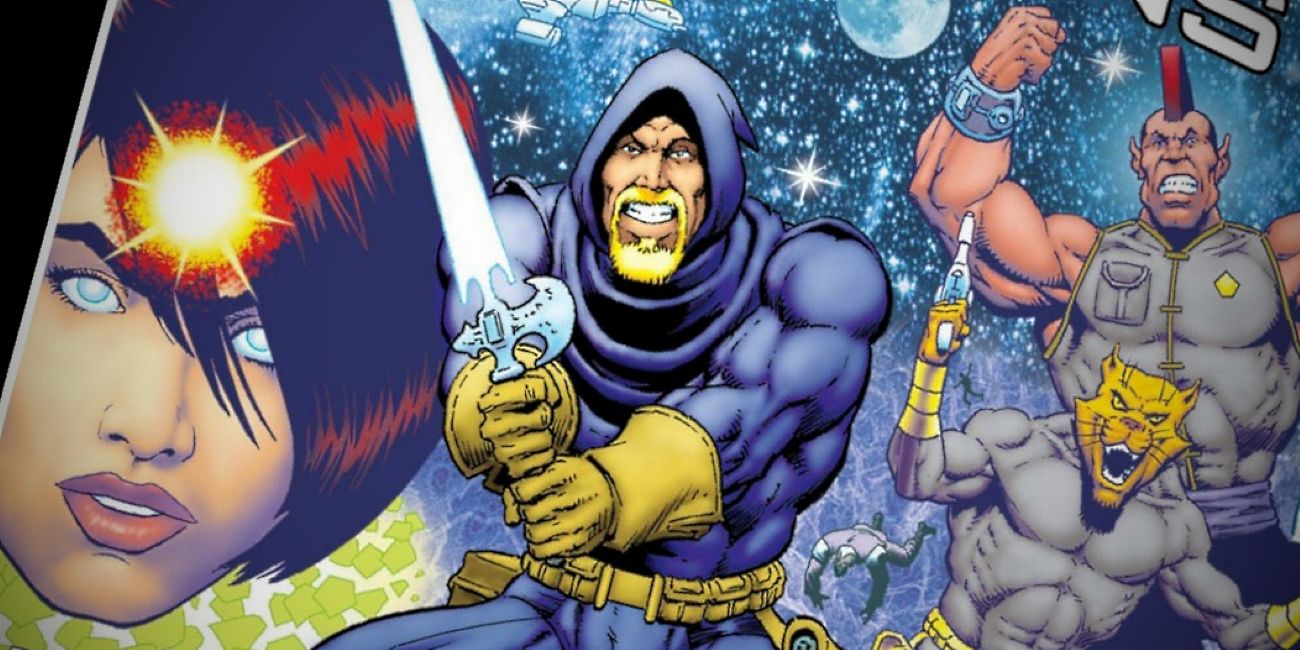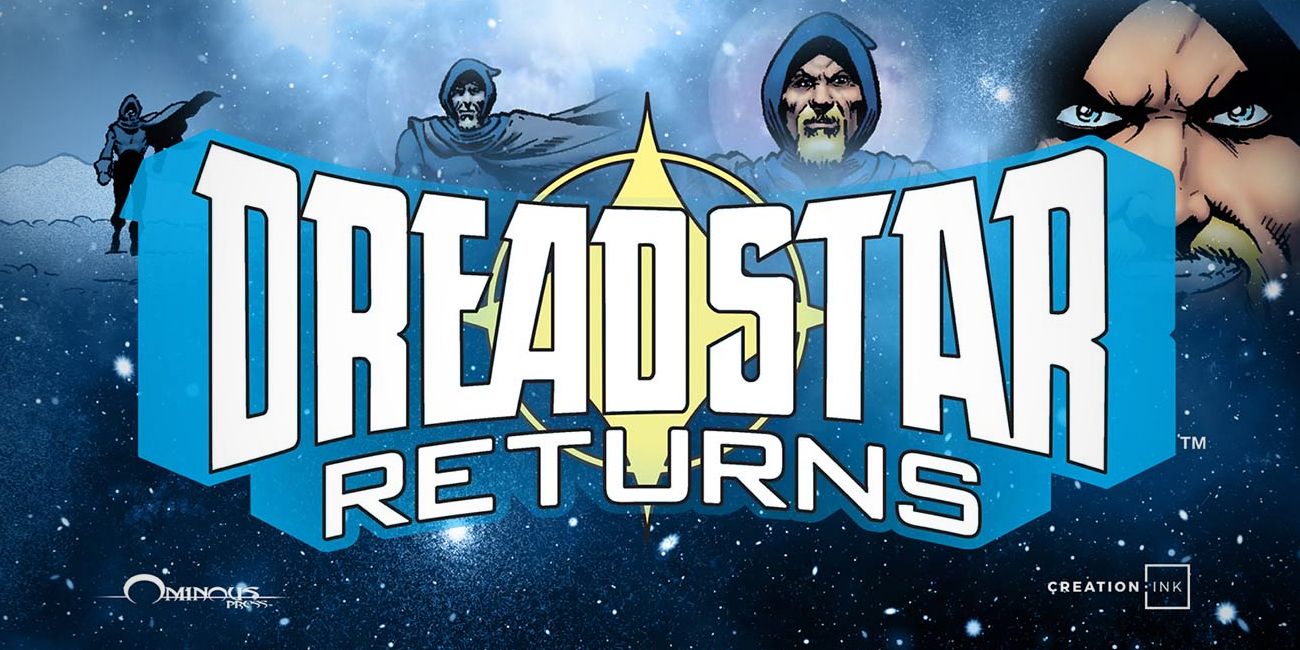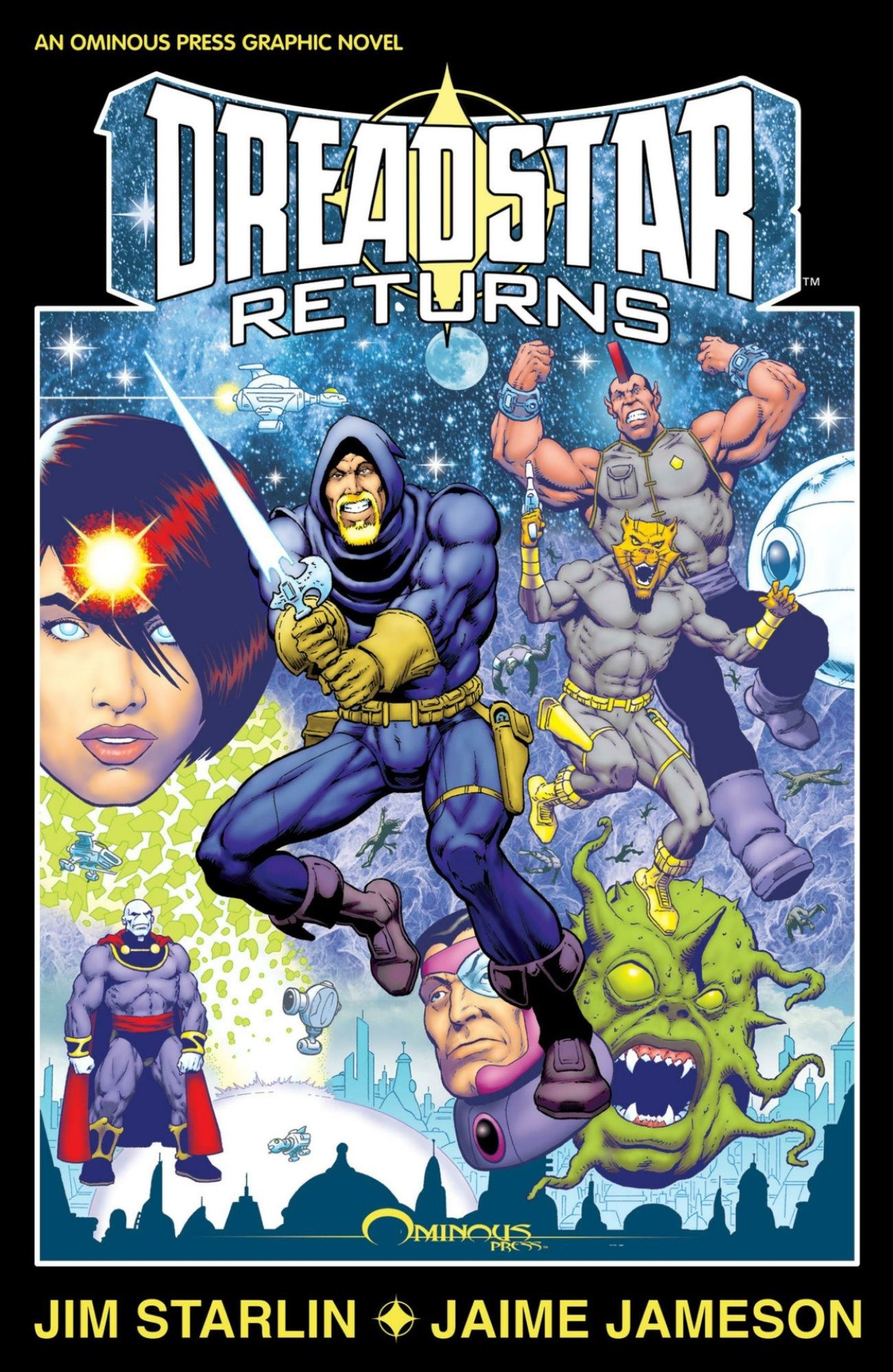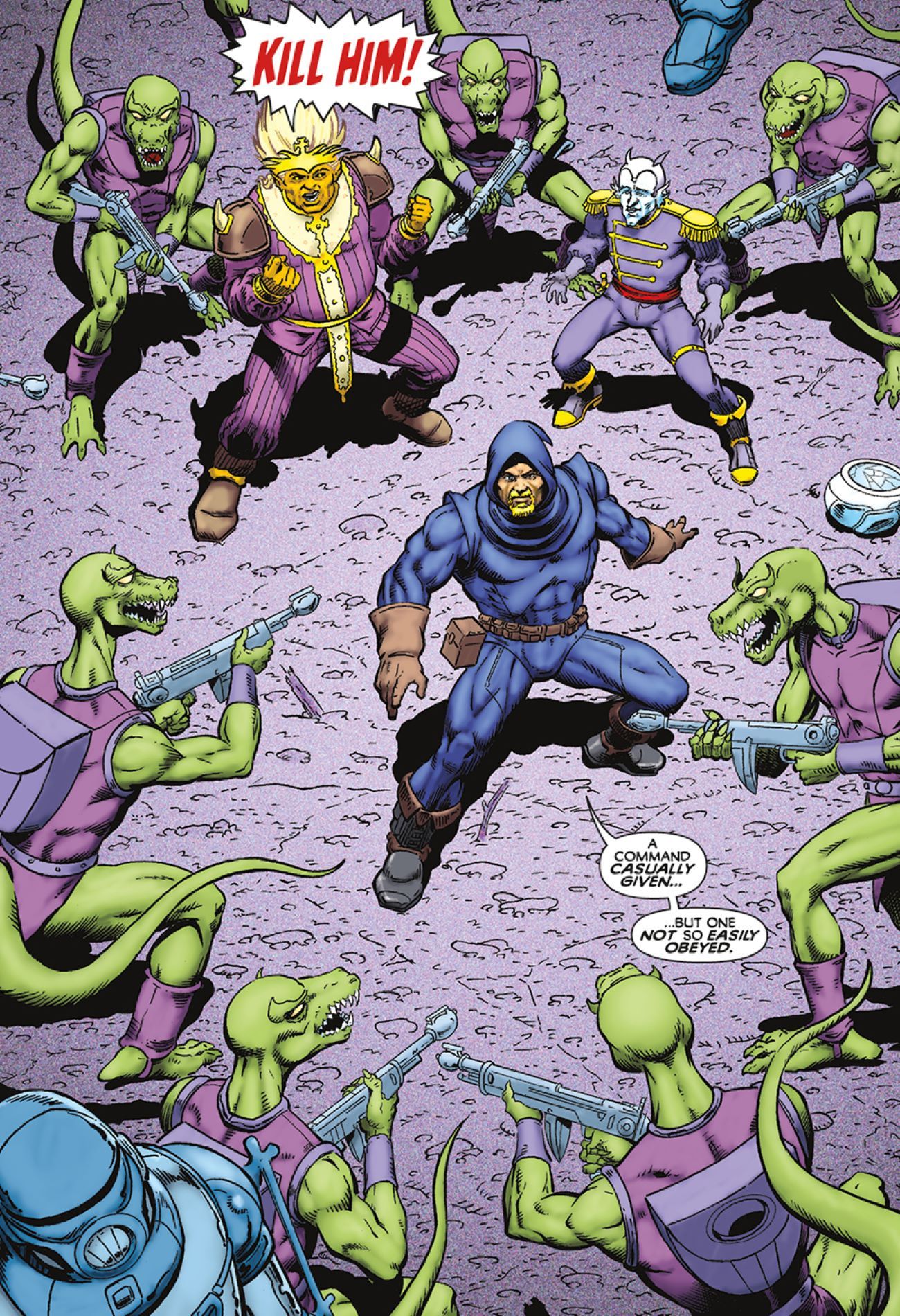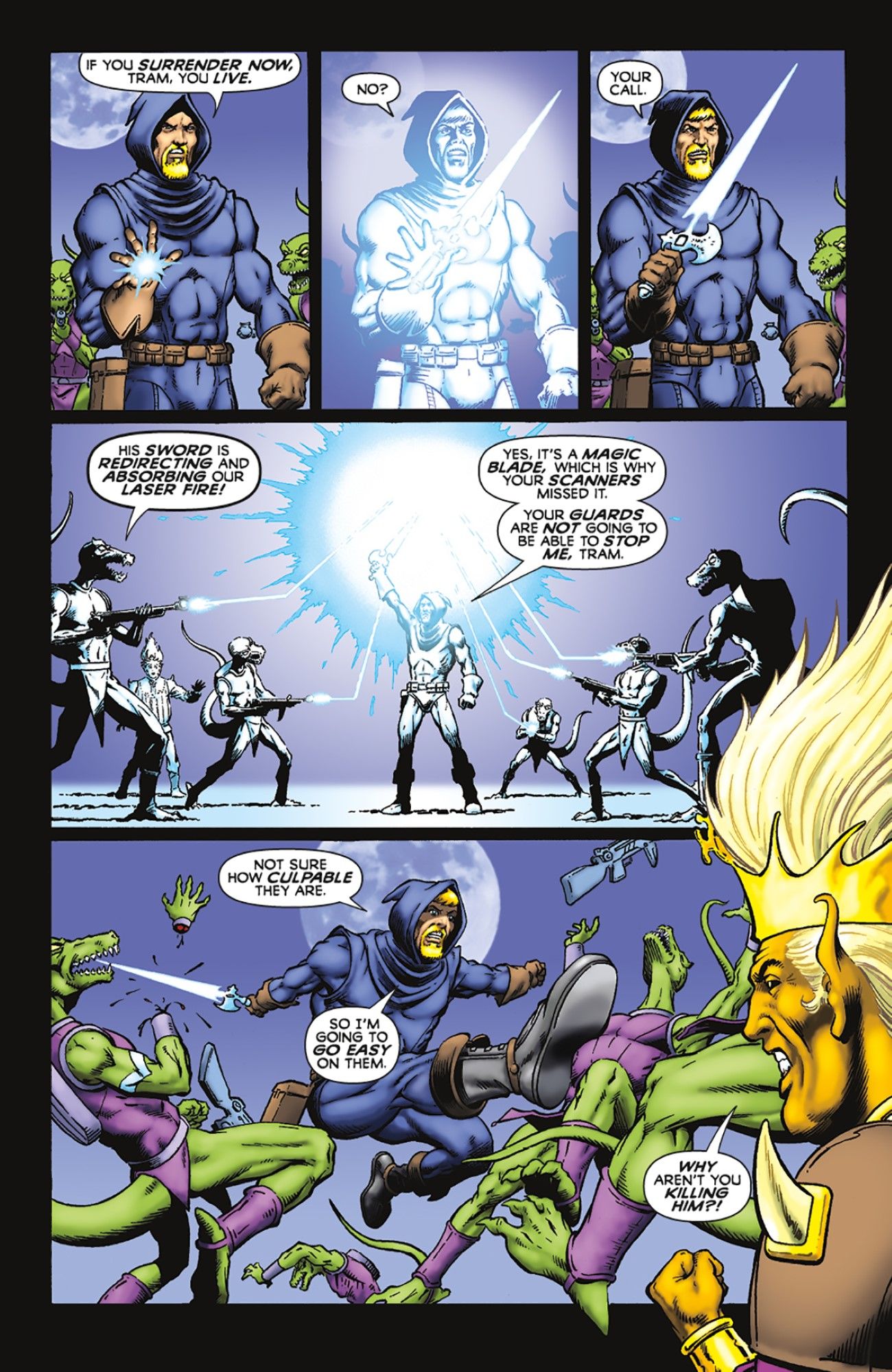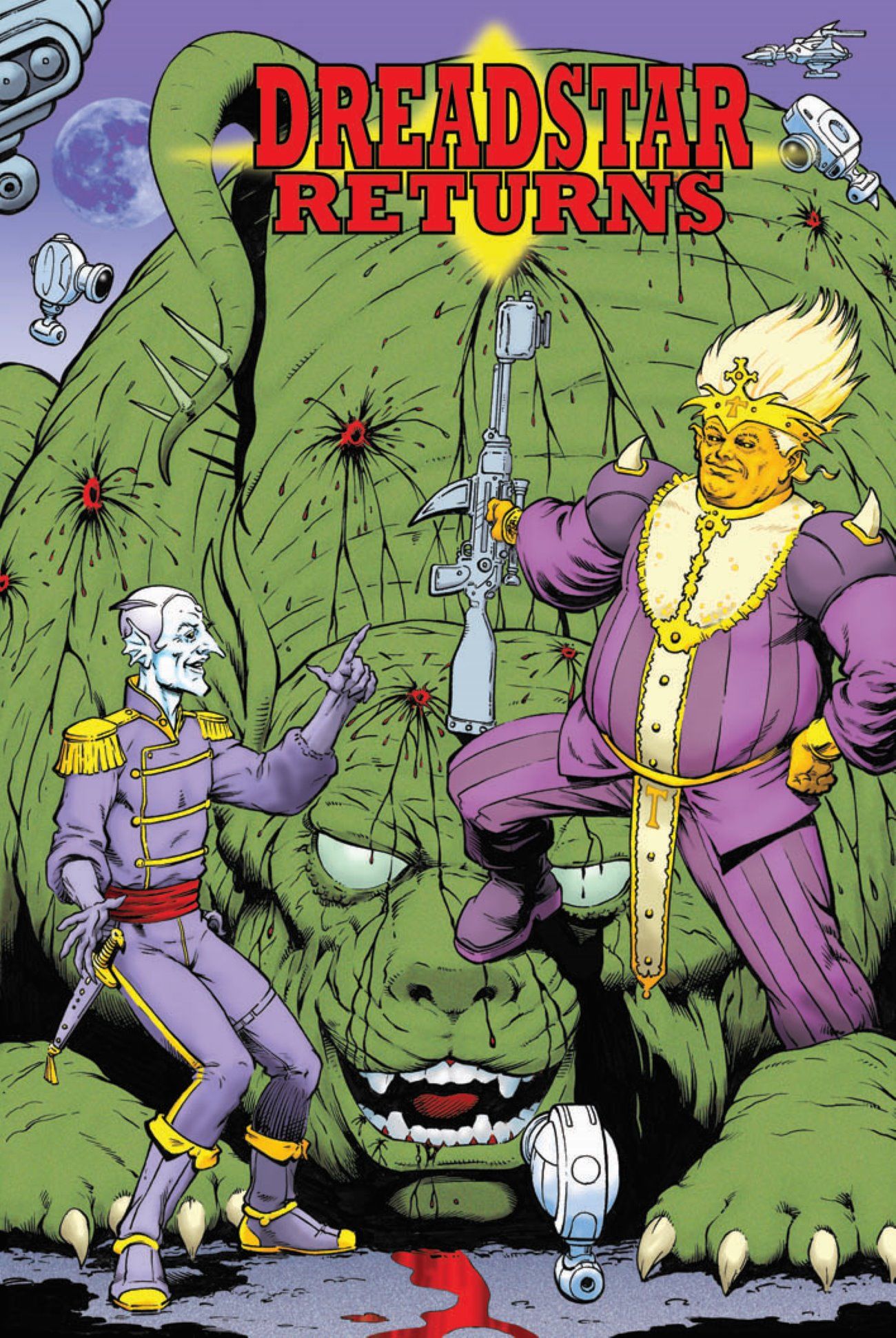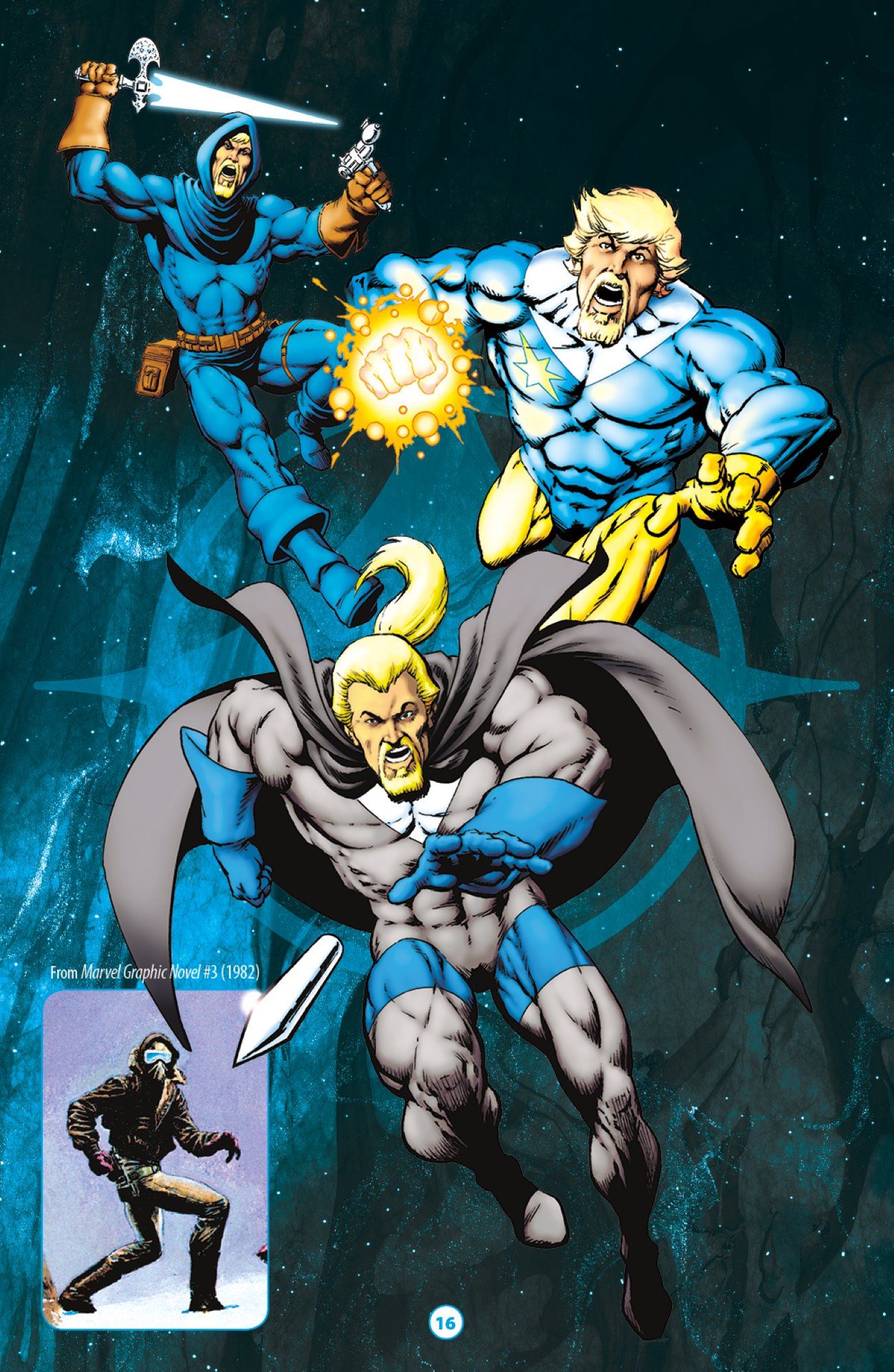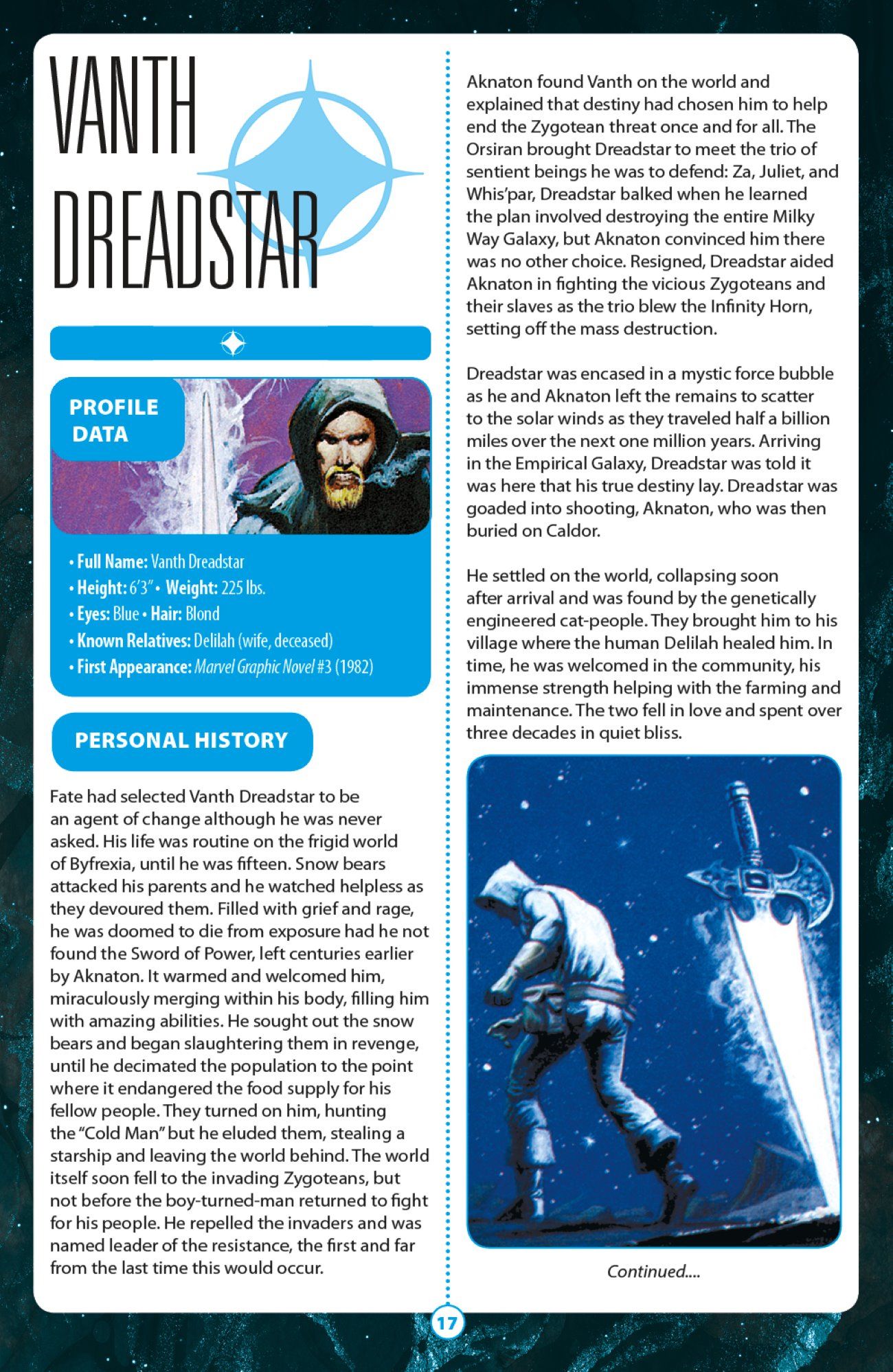The world may know Jim Starlin's infamous creation Thanos and his beloved Infinity Gauntlet thanks to Marvel's films, but with the launch of Dreadstar Returns, the legendary comic writer and artist is returning to the science fiction space opera limited only by his own imagination. And according to Starlin, the return of Vanth Dreadstar is getting his very best.
The impact of Starlin on the Marvel universe is well known, having created cosmic characters like the aforementioned Thanos, Gamora, Drax the Destroyer, and more as part of his Infinity Gauntlet epic and related mythology. But after an injury seemed to end his career as an artist, Starlin has taken to Kickstarter (shattering funding goals completely) to deliver a return to his other favorite son. The result is Dreadstar Returns, a 100-page hardcover original graphic novel written and drawn by Starlin, with inker Jaime Jameson. In addition, fans can also add The Dreadstar Guidebook to their collection, a 100-page hardcover companion volume chronicling the history and characters from the saga.
Fortunately, Screen Rant got the chance to speak with Starlin and Jameson about his other favorite comic creation, operating without supervision from the big two publishers, what makes Vanth Dreadstar so irresistible, and more. Readers can find the entire interview below, and order their own copies of Dreadstar Returns and The Dreadstar Guidebook by Robert Greenberger direct through Kickstarter now.
Screen Rant: You've described Vanth Dreadstar as one of your two favorite creations next to Thanos. Everyone even remotely interested in comics is now an expert on Thanos and the Infinity Gauntlet, but for both fans who know, what is it about Vanth that makes him stand apart as your favorite?
Jim Starlin: He's an anarchist without a second act. Also, he didn't kill me, like my other favorite son did. And so, he's become number one now. Thanos is number two; ungrateful sons go back down the line.
What I like about Dreadstar is the fact that he is mine to play with entirely. He's manipulative; I can take him wherever I want, and he goes along and plays along. He doesn't have any editor with six months experience behind him going, "No, no, you're doing it all wrong." So, we're having a good time working together.
For you Jaime, whether having read Dreadstar prior to this, or with your experience now, can you give your own view on what makes Vanth a singular hero?
Jaime Jameson: He's finally found his purpose, maybe? But he's a hot mess. I actually really like him, just because he - as Jim said - doesn't have a second act. He just comes in and destroys everything.
Jim Starlin: But he's not your favorite. Who's your favorite?
Jaime Jameson: Oh, my favorite character? No, Oedi is my favorite. And I also love Teuton, because he gives humor to the book. But Oedi is my favorite character. No, he's cute. He's a cat, come on.
Jim Starlin: We're thinking about putting videos out of Oedi just playing the piano.
Your Marvel creations have obviously stood the test of time -- but are still confined to a larger publisher catalogue. I think readers would actually be surprised to find just how blow-the-doors-open the Dreadstar mythology or cosmology really is.
Jim Starlin: Yeah, it's not the kind of thing you can make a movie on. It's a TV series, if anything. It's a complex story, and I always felt that where he goes is pretty much determined by what input I'm getting in life.
I started off doing a fairy tale. That's what the Metamorphoses Odyssey was supposed to be. It didn't work; I don't do fairy tales, I found out. Science Fiction was more of my forte, and it soon turned into the Dreadstar show, because Aknaton was the lead character who worked well in the fairytale, but it was Dreadstar who was going to take over the science fiction story.
The story determines where he is going, and what input in life is happening is where the story goes. Dreadstar as the main character didn't show up until the fifth installment of the Metamorphoses Odyssey. As soon as he showed up, I went, "Why am I playing with his bald guy with the pointy nose? This one's much more interesting."
I'm still curious to know what it takes to create a world that massive right out of the gate, or how much it changes in the act of writing.
Jim Starlin: One of the things I find right now is, if I was working with main major companies, the fact that they want to know everything right from the start. It has to be cemented down; they want everything in the synopsis, and then if you veer from it, they freak out. And that's not the way I've ever worked.
When I was playing with Captain Marvel, Roy Thomas, who was the editor at the time, was too busy to micromanage. And so I would come in and say, "It's Captain Marvel versus the Super Skrull," and he'd go, "Go for it." I love just flying by the seat of my pants as I'm going through these.
So no, these worlds were not mapped out ahead of time. I had this idea in Dreadstar that they were the Monarchy and Instrumentality, and it developed issue by issue. I just made sure I stayed consistent with the continuity that I had already established, but anything else was fair game. If I had a notion, that's where I wanted to go with it. And because I wasn't connected either the DC or Marvel Universe, I could change whatever I wanted, and it was always the story itself that made that determination.
That really supports the old notion that the real comic history is made when nobody is watching.
Jim Starlin: The less people involved, the more artistic integrity there is in a job. At this point here, it's pretty much Jaime and I talking on the road. In Dreadstar Returns, we're talking on the phone across the country at each other.
Jaime Jameson: Or FaceTime. And now we can actually work together in the same state.
Jim Starlin: The ideas flow much more freely. And it's a closed circle. We don't have a lot of other input coming in. There's nobody telling us that Dreadstar has to have a dog.
Jaime Jameson: He should, except the dog would die.
Jim Starlin: Yeah, freelance artists and writers who don't work for the major companies are the cats of the comic book world. We may be very cool and that, but we may end up dead in some alley somewhere. Starved to death, eating out of garbage cans.
Jaime Jameson: Nooo! I like food too much.
Jim Starlin: Yeah, well, it hasn't happened so far. Stick with me, and I'm sure I'll bring you to a bad end.
The world and mythology of the Dreadstar Universe is massive, even for the number of issues released over the years. Assembling the Dreadstar Omnibus and taking that to Kickstarter makes perfect sense, for the fans and and collectors. But when that campaign succeeded as quickly and enthusiastically as it did, was that encouragement to continue Vanth's story? Was that already in the works?
Jim Starlin: Well, the first thought is, thank God I can continue to eat. We don't have to have mustard sandwiches again tonight. No, it's very encouraging. Whenever anybody tells me they've been a fan, I go, "Well, thanks for keeping me alive, basically." I depend on the readership, and I try to honor that relationship as much as I can.
I have a number of folks, when it comes to autographs, tell me I should be charging more. But I'm going, "No, I don't want to gouge the people who have kept me alive all these years." I keep it down to a reasonable bit, and may give part of it to someplace like The Hero Initiative. But it's a relationship that I've tried to honor over the last few decades and will continue to do so.
When the idea of Dreadstar Returns became a reality, can you give some insight into how that story developed, and how Jaime came to be the go-to artist to assist you on this project?
Jim Starlin: Yeah, I was saying that a lot of it is in the moment, but the heart of the story and the structure of the story is all done ahead of time. I'm sitting here talking with Jaime about the next two books. We're well into Dreadstar Versus the Inevitable, but she and I are sitting here talking about what the next one is about. And I'm telling her, "You've got to go read these Peter David issues of Dreadstar, because what I want to do is go off from this point here inside that story."
I bounce ideas off her, she adds her two cents, and bits and pieces will be incorporated in down the line, probably. Not sure which, because that's still a book and a half away.
Jaime Jameson: But he knows we'll get there in the end.
Jim Starlin: When it came down to redesigning Willow, it was a nightmare. She just flooded me with jpegs.
Jaime Jameson: I'm the one that said, "Willow needs an update. She is not very sexy anymore." She was quite dated, so I just bombarded him with pictures of hairstyles, jogging outfits, leotards and different things. Boots! Yes, a woman and her shoes. And then Willow got a whole new look.
Jim Starlin: That was one of those things that was spur of the moment too. That wasn't in the original story. I'd gotten to that point, and she had been lobbying for a change in Willow. And I said, "Okay, I might as well get this out of the way."
Jaime Jameson: But you're pretty happy with it.
Jaime Jameson: I mean, we generally just [discuss] a lot of stuff. We're talking about lots of other things too, actually. We bounce a lot of ideas off each other. I wouldn't say I've been like, "No, that just doesn't work." That hasn't happened.
Jim Starlin: It's more like we just discuss things, and they shift in the place. I'm not exactly that I always am in command of a story. Sometimes it seems to be that, I've gotten to this point and I can't go there. So, I have to go here.
She harassed me for the original drawing of Dr. Doom, which I told you about. But other than that, it's more that we talk and collaborate. I think some ideas are good, and some ideas I just ignore.
Jaime Jameson: He's also talking about his own, mind you. About Dr. Doom, he was upset I didn't ask for Thanos.
Jim Starlin: Oh, yeah. I had blown a big hole in my hand about four years back and had stopped drawing, because I couldn't. I'd spend five minutes with a pencil in my hand, it would swell up, and I'd have to plunge it into ice water to keep it from cramping up any further. But I still did the hand exercises, the squeezing of the rubber ball, that sort of thing.
And I was working on the Dreadstar omnibus using a stylus to help me remaster the digital files - or create the digital files, actually, for the book. Because this was all analog; a lot of it was film when we had it, so everything had to get remastered in some way or another. And Jaime came along at a convention that I was at, through Spencer Beck, my appearance agent. And she wanted a sketch of Dr. Doom, which put me off because I said, "If I'm going to do a sketch of anybody, it'll be Thanos." I said, "Okay, yeah. As soon as I get a chance, I'll do this."
She kept pestering me. She kept showing up, and she'd have this cute smile on her face, but she wasn't going to be turned down. Eventually, after one of these conventions, I sat up in my hotel room, and I did the drawing just to get rid of her - to get her out of my hair, which I don't have any longer. That's really a lame metaphor, I guess. But it went really easily. It wasn't the best drawing I ever did, but my hand didn't make at the end of it.
She got her drawing, and I went home and did some other drawings, which I figured I'd sell at conventions. But I quickly found that I wasn't gonna make it. My hand was good enough for the pencils, but it was never going to be inking - especially not a whole book. So at the next convention I was at, Jaime had been working with Keith Giffen as his inker. She showed up at convention expecting him to show up also, and he didn't - which Keith has the habit of doing sometimes.
Jaime Jameson: Even when Keith's there, he's not necessarily there.
Jim Starlin: So, I asked her to ink these convention sketches while she was sitting around, and I really liked the way they looked. I was surprised. I said, "This pest can really ink. And so when I came to do in the book, I approached her and said, "How would you like a regular gig? 100 pages." She agreed, and didn't have the confidence for the job originally, I found out. Apparently, there was a lot of wailing and tears. "I can't do this. I can't do this," and Joel Adams and would say, "Yes, you can," and show her how.
Jaime Jameson: He was like, "Just put down the first line, just put down the first line." These white paints you can screw up.
Jim Starlin: And even after she got going, I'd get these phone calls that go, "I just can't do this. You've got to find somebody else to do it." And I'd go, "Yeah, I understand where you're coming from. But will you have this page done by tomorrow so I can color it?"
Jaime Jameson: Yep! He just kind of totally went over what I was saying, and he was like, "Oh, yeah, no. I get it. So, I need to color tomorrow."
Jim Starlin: "I need 10 more pages tomorrow."
Jaime Jameson: And I also was sick with COVID, so there was a lot of that,
Jim Starlin: Oh, yeah, she almost died. She had it not once, but twice during this job.
Jaime Jameson: We didn't know COVID was here the first time I got it. I passed out in the airport. All of a sudden, I had a super high fever, and they were like, "You have a rare form of pneumonia." That was the end of January or early February, somewhere around there. And then it comes to the end of March, and I got walloped really hard. The first time was bad enough, but the second time? I was in my bed for like three and a half months. Nobody could be there, of course, and I was really sick. Ambulances came; I went on many trips to the hospital, and it was really weird because they wouldn't even come in to do your X-ray. They were telling you how to do your own X-ray; it was really bizarre.
Jim Starlin: I can't remember exactly where we were at when you [got sick].
Jaime Jameson: That was before; we got the Kickstarter before I got sick. Because we had already started before we did that con in Mexico City. We actually started the book before, because we had to do 10 pages.
I mean, it was pretty amazing to see it just go. And of course, it was like, "This is gonna be huge, so I really need to be able to do this. 100 pages, huh?"
Jim Starlin: Yeah, they were points where I just didn't think she was going to make it period, let alone finish the job. So, we celebrate every day that she's still with us and still producing, and I can still harass her about getting out another page for me to color.
So Vanth has a long backstory here, but you have described him as an anarchist with no second act. That also implies that Vanth as a character almost needs no introduction. But can new readers actually start from here?
Jim Starlin: I tried to plot and design out the story so that someone could come in fresh, with no idea who the character was. I've been told that I succeeded at this by some of the folks who have read it. We also threw in a little two-page thing at the beginning of the book, which gives each character a bit of a synopsis of who they are. I've also been told that was not needed, but I think that's a big help anyhow.
I'm pretty confident that a first-time reader can come in here, just pick up this book cold and enjoy it. It's a rollicking good adventure, as folks used to say. It's an unrequited love story that starts off with a bit of tongue-in-cheek political humor, and then goes off into the main story itself. The first 20 pages are a bit of diversion, I would say, and then we get into the meat of the matter.
And it was fun because it was 20 some odd years since I had done the book, worked on Dreadstar, and I wanted to have that same time lapse in the continuity. So, I sat down to figure out what each character would be doing 20 years later. Vanth, who had always had this destructive "I can break it but I can't live in a society that is actually functioning" problem, has finally found a way to use his destructive tendencies in a constructive way. And so he's fitting into this society in a strange way, and all the other ones have found their little niches.
As I was going through this, I remembered one character who was in the series who I always thought I'd given short shrift to. So, I went back and I looked at this character - and I'm not going to say who it is, because that's a spoiler for the story. But this for character, I went back and said, "Well, what happens if this happens," and so, I came back to conclude this character's story. That's basically our unrequited love story, and I hope everybody enjoys it. We had a great time doing it.
Someone might ask, "how do you keep a return to just 100 pages" but that's a moot question now that we know DREADSTAR VS THE INEVITABLE is also on the way. So what can you tell us about that?
Jaime Jameson: I would say that the next book, even we did this book during the pandemic, is probably going to be our pandemic book. And just as Jim has stated in previous interviews, sometimes things are just inevitable. Sometimes you don't have control over things that happen in life. If there's one thing we learned this year, it's the fact that you cannot predict and you cannot control certain things. I would say that's kind of where the next book will be going.
Dreadstar Returns and the Dreadstar Guidebook are available to order now by visiting the official Kickstarter website.

